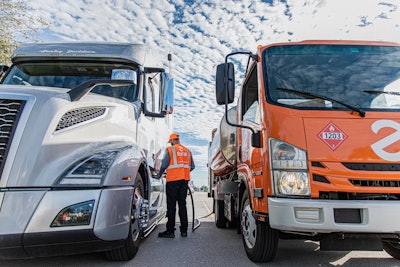
There is no doubt that we have entered economic times unseen in decades. With supply chain issues affecting deliveries throughout the United States, and the Coronavirus disease (COVID-19) continuing to impact business, fleet managers are looking for new ways to increase their productivity and efficiency.
Mobile fueling is still underutilized in many parts of the country, but it is rapidly gaining steam in a number of cities, including Miami, where more and more companies are recognizing that participation in a mobile fueling program can save them time and money as well as potentially improve the climate.
Fleet owners in particular are increasingly utilizing fuel delivery providers to fill their tanks at their own place of business, removing the need for drivers to search for fuel and wait in line at local gas stations. On-site delivery of fuel during downtimes not only enables drivers to begin their daily operations with fully fueled vehicles, but also allows them to avoid potential hazards associated with handling dirty and contaminated gasoline pumps. According to a study by Busbud, gasoline pumps can be up to 11,000 times dirtier than a public toilet seat.
Here are four ways on-site gas delivery is helping fleet owners save both time and money in a hyper-busy and competitive business environment:
Improved employee productivity
The on-demand mobile fuel industry enables fleet owners to focus almost exclusively on the revenue-generating activities of their business without having to deal with disruptions due to stops to refuel the fleet vehicle. Gas station trips can take as much as 20 minutes on average, per day, which is time away from the business of the fleet. On the other hand, mobile on-site gasoline and diesel delivery reduces stops for drivers and helps keep them on schedule – mobile fueling takes place when the fleet is parked and when drivers are off duty, resulting in fully fueled vehicles for the operator as new shifts begin.
Reduced wear and tear
The correlation between miles driven and wear and tear on fleet vehicles is also well documented. The maximum life of a vehicle is directly related to the number of hours and miles that it is being operated. Maximizing the number of deliveries is one of the key objectives of fleet management. Mobile fueling enables the vehicle to stay on schedule and return to base immediately when the route is complete. This removes the requirement for fleet drivers to spend any amount of time driving for gas, saving on wear and tear as well as driver unproductivity.
Lower fuel costs
When the route is completed, a driver can now go directly to their home base instead of stopping to refuel at an out-of-the-way gas station. That means no wasted miles or time searching for and pumping gasoline. Moreover, retail gasoline pricing can vary as much as $1 per gallon between stations no further than five miles apart. With mobile fueling, there is one price – a negotiated price –universal across the fleet. That allows fleet operators to better manage their fuel expenses, resulting in more certainty and peace of mind. Fleet managers can be sure that every gallon purchased by their operators is put into their rolling assets as opposed to another vehicle. And, mobile fuel delivery prevents drivers from potentially falling victim to credit card skimming.
A cleaner environment
Mobile fuel delivery is also better for the environment. Vehicle emissions are simply a product of the duration of time that the internal combustion engine is operating. According to research conducted by Wonder, “fleet owners spend 62 hours per year, per vehicle to refill fuel tanks.” With mobile fueling, these same vehicles can now simply return to base after the route is completed. Moreover, the emissions historically released by traveling to a gas station, fueling and then returning to base are completely removed. The benefits of reduced vehicle emissions will vary from fleet to fleet depending on many variables -- proximity to fueling station, size of the tanks, etc.
Rising labor and fuel costs as well as daily wear and tear of vehicles affects fleet profits and makes every penny (and mile) count. As a result, the increased adoption of the delivery of products and services – including gasoline and diesel – to places of businesses has become the preferred method for many fleet owners. With operators realizing the cost and convenience benefits of mobile fuel delivery, this trend is expected to continue expanding well into the post-pandemic economy.















![Pros To Know 2026 [color]](https://img.sdcexec.com/mindful/acbm/workspaces/default/uploads/2025/08/prostoknow-2026-color.mduFvhpgMk.png?ar=16%3A9&auto=format%2Ccompress&bg=fff&fill-color=fff&fit=fill&h=135&q=70&w=240)


